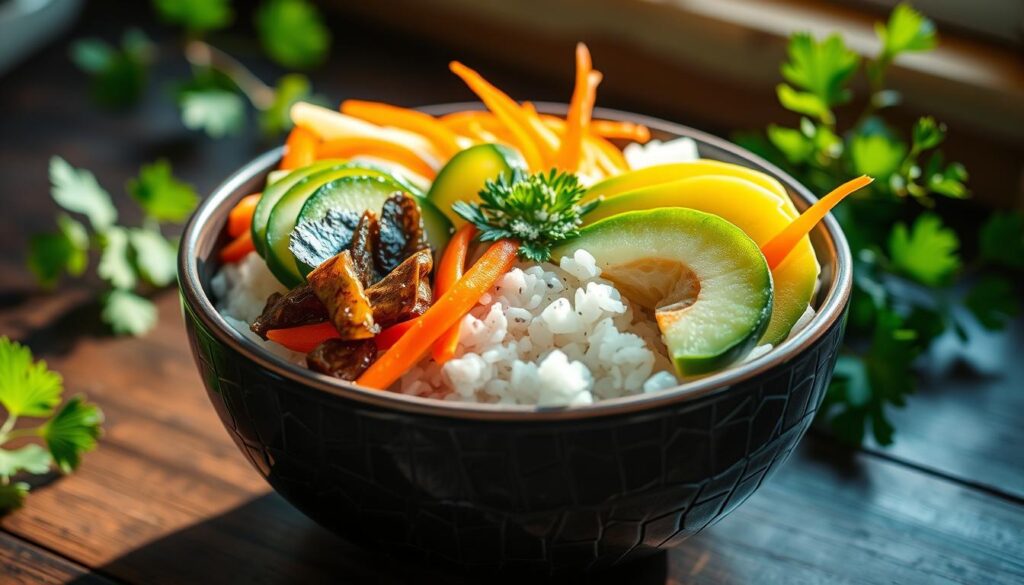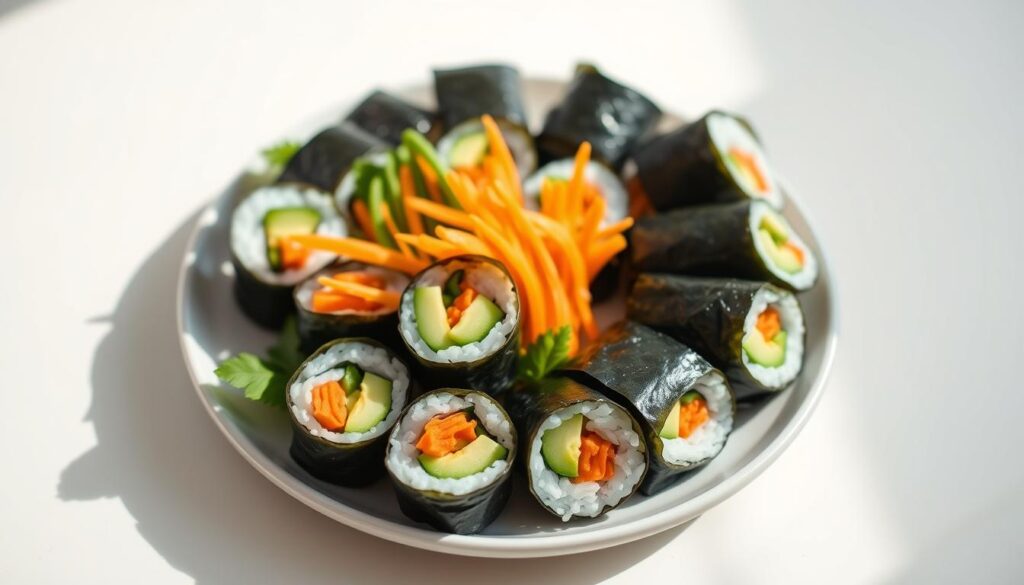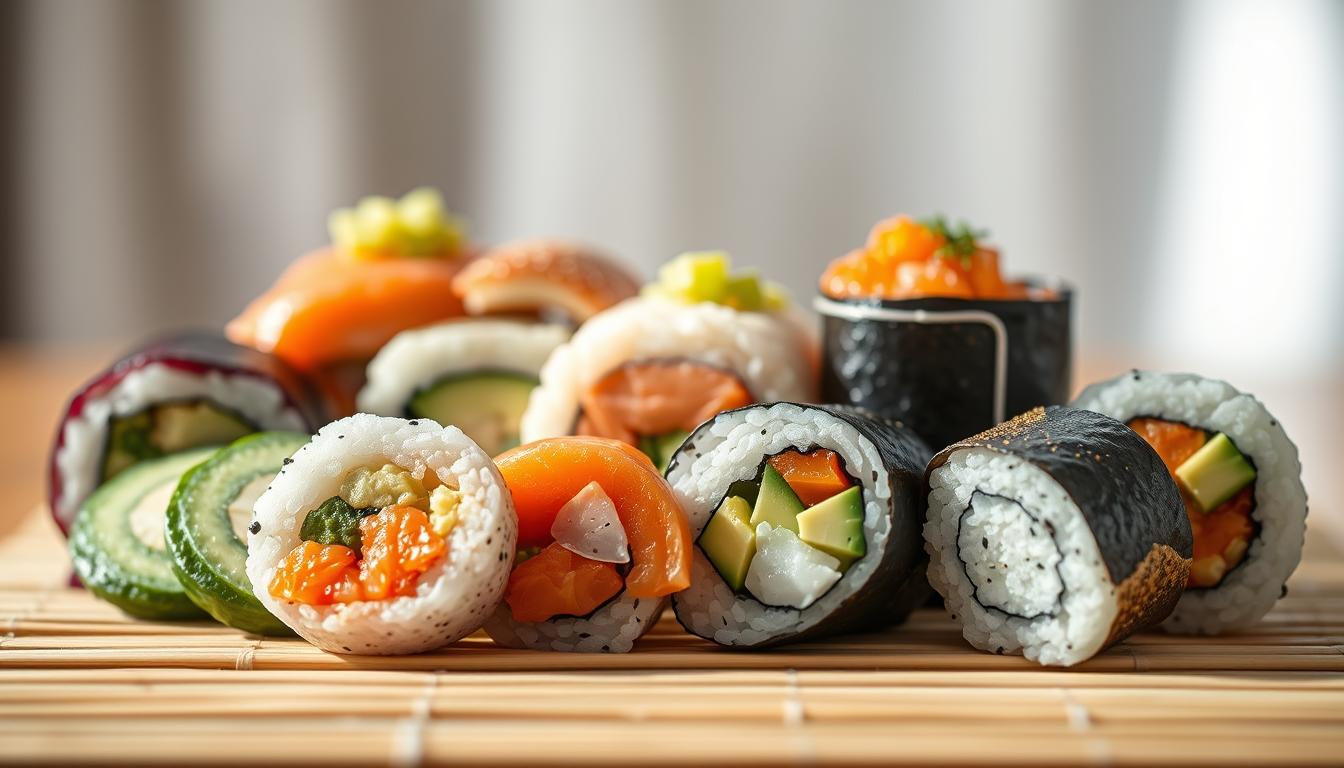Best Gluten-Free Sushi Recipes That You Can Make At Home
Table of Contents
Imagine making top-notch Japanese food in your kitchen, without gluten worries. Sushi is a favorite dish, but it can be hard to make at home if you have dietary limits. Gluten-free sushi recipes are here to make cooking at home a breeze.
Japanese cooking is all about simplicity and detail. With a few ingredients and techniques, your kitchen can become a sushi paradise. Whether you have celiac disease or just want to eat healthier, gluten-free sushi is a tasty option that doesn’t lose flavor.
This guide will teach you all about making tasty gluten-free sushi. You’ll learn about safe ingredients and how to roll sushi like a pro. You’ll see how easy and fun Japanese cooking can be. Get ready to wow your loved ones with homemade sushi that’s both safe and delicious.For more similar recipes, check out Our Flavors.
Introduction to Gluten-Free Sushi Recipes
Sushi lovers with gluten sensitivities can rejoice! Making tasty Sushi Roll Recipes that are safe for allergies is easier than you think. Knowing the right gluten-free ingredients is key to making safe and delicious sushi rolls for all.
The world of sushi can be tricky for those avoiding gluten. Traditional Japanese food is often gluten-free. But, some ingredients need careful picking to ensure a safe meal.
What Makes Sushi Truly Gluten-Free?
Several key factors make sushi gluten-free:
- Rice selection: Traditional sushi rice is naturally gluten-free
- Nori (seaweed) wraps: Completely gluten-free
- Fresh fish and vegetables: Safe for gluten-sensitive individuals
- Potential gluten sources: Soy sauce, imitation crab, marinades
Popular Gluten-Free Ingredients
When making Allergy-Friendly Sushi, consider these alternatives:
| Ingredient | Gluten-Free Alternative |
|---|---|
| Soy Sauce | Tamari or Gluten-Free Soy Sauce |
| Imitation Crab | Fresh Crab or Gluten-Free Surimi |
| Marinades | Homemade Gluten-Free Marinades |
With the right ingredients, you can make delicious gluten-free Sushi Roll Recipes for everyone. The trick is knowing what ingredients to use and making smart swaps.
Essential Ingredients for Gluten-Free Sushi Recipes
Making Healthy Sushi Alternatives at home is all about the right ingredients. Gluten-free sushi needs careful picking to be safe and tasty. Let’s look at the key parts for making Rice Wraps and sushi fun and healthy.
Types of Gluten-Free Rice
Sushi rice is the base of your gluten-free sushi. Japanese short-grain rice is the best for perfect sushi. Here are some important facts about sushi rice:
- Needs 3 cups of cooked rice for maki sushi
- Seasoned with a special vinegar mix:
- 3-4 tablespoons of sugar
- 1/3 cup of rice vinegar
- 1 teaspoon of salt
- Tip: Always check rice packaging for gluten-free safety
Seaweeds and Their Gluten-Free Properties
Nori sheets are key for Rice Wraps and sushi rolls. Most seaweeds are gluten-free and full of nutrients. A typical maki sushi roll uses about 6 sheets of nori.
Gluten-Free Sauces and Condiments
Choosing the right sauces is vital for Healthy Sushi Alternatives. Use gluten-free tamari instead of soy sauce. Good options include:
- Gluten-free wasabi
- Japanese mayonnaise (certified gluten-free)
- Tamari sauce instead of regular soy sauce
Pro tip: Always read labels carefully to ensure complete gluten-free status of your ingredients!
Simple Gluten-Free Sushi Roll Recipes
Making gluten-free sushi rolls at home is easy. You can enjoy these tasty dishes if you have dietary needs or just want to try something new.
These recipes are simple, healthy, and full of flavor. We’ll show you three gluten-free sushi rolls that suit different tastes and needs.
Classic California Roll
The California roll is a great start for vegetarian sushi lovers. Here’s what you need:
- 1 cup sushi rice
- 1.5 cups water
- 3 tablespoons rice vinegar
- 1 avocado, sliced
- 1 cucumber, julienned
- Nori sheets
Spicy Tuna Roll
For those who like spicy food, this roll is a must-try:
- 1/2 lb sushi-grade tuna
- 2 tablespoons sriracha sauce
- 1/4 cup Greek yogurt
- Green onions for garnish
Vegetable Sushi Roll
This colorful roll is perfect for those with dietary restrictions:
- 3 large carrots
- 1 avocado
- 1 English cucumber
- 5 sheets dried seaweed
- 10 rice paper wraps
When making these vegetarian sushi rolls, use gluten-free ingredients. Also, check labels to ensure they meet your dietary needs. Each roll has about 171 calories and is a good mix of nutrients.
| Nutritional Information | Per Serving |
|---|---|
| Calories | 171 |
| Sugar | 1.9g |
| Sodium | 277mg |
| Fat | 8.2g |
| Carbohydrates | 11.7g |
| Protein | 15.1g |
Pro tip: Use a bamboo mat for rolling and ensure your rice is perfectly cooked to create restaurant-quality sushi at home!
Creative Gluten-Free Sushi Bowl Recipes
Ready for something new? Sushi bowls are a fun twist on traditional sushi. They mix your favorite flavors into one tasty dish. Plus, they’re easy to make and perfect for those who love Vegan Sushi Ideas.

Sushi bowls are easy to make and don’t require rolling. You can pick your favorite ingredients to create a dish that’s just right for you. They’re great for anyone who wants to enjoy Japanese food without the fuss.
Surprising Sushi Bowl Combinations
Try these unique sushi bowl ingredients for exciting flavors:
- Teriyaki tempeh for plant-based protein
- Crispy edamame for added crunch
- Pickled vegetables for tangy notes
- Seaweed Snacks as a garnish
Easy-to-Make Sushi Bowls at Home
Making sushi bowls is easier than you think. Here’s what makes a great sushi bowl:
| Ingredient Category | Percentage | Quantity |
|---|---|---|
| Grains | 38% | 1½ cups brown rice |
| Proteins | 15% | 1½ cups edamame |
| Fruits & Vegetables | 47% | Mango, avocado, cucumber |
Tip: Get your ingredients ready before you start. Meal prep makes cooking stress-free!
A sushi bowl is like a deconstructed sushi roll – all the flavor, none of the fuss!
With these Vegan Sushi Ideas, you’ll make your cooking more fun. You’ll impress everyone with meals that are both healthy and tasty.
Sushi Making Techniques for Gluten-Free Sushi Recipes
Mastering Japanese cuisine through Sushi Roll Recipes needs practice and understanding of key techniques. Learning to make perfect gluten-free sushi at home is an exciting culinary adventure. It turns your kitchen into a personal sushi restaurant.
Preparing delicious sushi involves several crucial steps. These steps can elevate your Japanese cuisine skills. Let’s explore the essential techniques for creating restaurant-quality rolls.
Rolling Sushi: Pro Tips and Techniques
Successful sushi rolling depends on several key factors:
- Use a bamboo mat for consistent rolling
- Maintain the correct water-to-rice ratio (1.5 cups water per 1 cup rice)
- Avoid overfilling rolls to prevent them from falling apart
- Use short-grain rice for optimal stickiness
Creative Sushi Rolling Alternatives
Not comfortable with traditional rolling? Consider these gluten-free alternatives for your Sushi Roll Recipes:
- Hand Rolls (Temaki): Easier for beginners
- Pressed Sushi (Oshizushi): Compact and uniform
- Sushi Bowls: Deconstructed sushi option
Each serving of homemade sushi contains approximately 273 calories, with 14 grams of total fat and 9 grams of protein. By practicing these techniques, you’ll create delicious gluten-free sushi that rivals restaurant quality.
Remember: Sushi making is a skill that improves with practice!
If you have questions about making gluten-free sushi, drop a comment below. We’ll be happy to help you perfect your technique.
Pairing Drinks with Gluten-Free Sushi Recipes
Choosing the right drink can make your gluten-free sushi meal unforgettable. Knowing about dietary restrictions opens up new drink pairing options. These can add to your homemade sushi experience.
Gluten-Free Alcoholic Beverages
Here are some tasty gluten-free drinks for your sushi:
- Sake: Traditional Japanese rice wine naturally gluten-free
- White wines like Sauvignon Blanc
- Sparkling wines such as Champagne
- Gluten-free craft beers
Non-Alcoholic Refreshments
For those who don’t drink alcohol, there are plenty of gluten-free drinks to enjoy with your sushi:
- Green tea
- Sparkling water with citrus
- Kombucha
- Cucumber-infused mocktails
| Drink Type | Sushi Pairing Recommendation |
|---|---|
| Sake | Pairs perfectly with raw fish rolls |
| Sauvignon Blanc | Complements vegetable and seafood sushi |
| Green Tea | Cleanses palate between sushi bites |
Remember, what you like is most important when trying different drinks. Try out various pairings to find your top choices for gluten-free sushi drinks.
Creative Serving Suggestions for Gluten-Free Sushi Recipes
Turning your gluten-free sushi into a work of art is all about presentation and garnishing. It’s not just about the ingredients. It’s about creating a feast for your senses.
Plating Your Sushi Beautifully
Your sushi’s look can make a big difference. Try these creative ways to plate:
- Use minimalist white plates to highlight the colors of your sushi
- Create geometric arrangements with rolls and garnishes
- Incorporate natural elements like bamboo boards or slate plates
Garnishes That Enhance Flavor
Seaweed snacks and fresh ingredients can make your sushi look and taste better. Here are some garnishing ideas:
| Garnish | Flavor Profile | Visual Impact |
|---|---|---|
| Microgreens | Fresh, peppery | Bright green accent |
| Sesame seeds | Nutty, toasted | Delicate sprinkle |
| Citrus zest | Tangy, bright | Colorful garnish |
Remember, presentation is an art form. With a little creativity, your gluten-free sushi can be both tasty and beautiful.
Meal Prep Tips for Gluten-Free Sushi Recipes

Making Healthy Sushi Alternatives at home needs good planning and smart prep. Preparing your sushi ahead saves time and keeps meals tasty all week.
Smart Ingredient Preparation Strategies
Good meal prep means knowing what can be done early. Here are tips for getting ready Allergy-Friendly Sushi ingredients:
- Cook sushi rice up to 2 days in advance and store in an airtight container
- Chop vegetables and proteins 1-2 days before assembling sushi
- Pre-mix gluten-free sauces and store in sealed containers
Storing Leftover Sushi Safely
While fresh sushi is best, you can store it safely with care:
- Refrigerate sushi immediately after preparation
- Consume within 24 hours for optimal taste and safety
- Keep raw fish-based sushi for no more than 12-24 hours
Pro tip: Separate rice, proteins, and vegetables when storing to maintain texture and prevent sogginess.
Maximizing Ingredient Freshness
When making Healthy Sushi Alternatives, keep ingredients fresh. Use top-quality ingredients and store them right to keep them fresh longer.
Follow these tips for easy, Allergy-Friendly Sushi prep every day.
Gluten-Free Sushi for Special Diets
Exploring dietary restrictions doesn’t mean giving up on delicious sushi. Vegan sushi ideas have changed how people with specific needs enjoy sushi. Whether you’re on a plant-based diet or looking for low-carb options, there are many creative ways to make tasty sushi rolls.
Sushi lovers with dietary restrictions can now enjoy a world of culinary possibilities. Vegan sushi options have become more advanced. They offer nutrient-rich alternatives that don’t lose out on flavor or texture.
Vegan Gluten-Free Sushi Options
Create delicious plant-based sushi rolls with new ingredients:
- Tempeh teriyaki rolls with crisp vegetables
- Marinated tofu and avocado combinations
- Roasted vegetable sushi with coconut aminos instead of traditional soy sauce
Coconut aminos are a tasty substitute with 63% less sodium than regular soy sauce. They’re great for health-conscious sushi fans.
Low-Carb Sushi Alternatives
For those watching their carb intake, try these exciting options:
- Cauliflower rice rolls (only 1.6g net carbs per cup)
- Quinoa-based sushi with high nutrient content
- Nori wraps without traditional rice
By trying these new approaches, you can enjoy sushi that fits your dietary needs. It’s both tasty and nutritious.
Hosting a Gluten-Free Sushi Night
Turning your home into a Japanese food spot is fun and tasty. A gluten-free sushi night lets you try Allergy-Friendly Sushi and make great memories with loved ones.
Getting ready for your sushi party needs careful planning and creativity. You aim to make a fun food experience that everyone can enjoy, no matter their diet.
Menu Planning Strategies
Here are key tips for a great gluten-free sushi night:
- Choose a variety of gluten-free ingredients
- Offer different protein and veggie choices
- Make your own sauces and condiments
- Have vegetarian and vegan options too
Interactive Sushi-Making Activities
Make your guests part of the sushi-making fun:
- Set up a DIY sushi roll station
- Have a sushi-rolling contest
- Give step-by-step rolling lessons
- Let guests pick their own ingredients
Your Japanese food journey can be both fun and learning. By focusing on Allergy-Friendly Sushi, you’ll make a dinner that’s fun for everyone.
Conclusion: Enjoying Gluten-Free Sushi
Starting your gluten-free sushi journey opens up a world of flavors and creativity. Healthy sushi alternatives are more than just food for special diets. They’re about trying new cooking methods that make simple ingredients into amazing meals. By learning these recipes, you’ve found a way to make tasty and healthy dishes.
When you make sushi at home, you can pick what goes in and try new tastes. Gluten-free sushi lets people with dietary needs enjoy Japanese food without losing flavor or texture. You can make everything from veggie rolls to spicy tuna, and even sushi bowls, all gluten-free.
Trying out gluten-free sushi ingredients is a fun adventure. You’ll learn to mix flavors, choose the best ingredients, and make dishes that look as good as they taste. Remember, the more you make sushi, the better you’ll get at it. You’ll become more confident in making these healthy, tasty meals.
We hope you’ll share your gluten-free sushi with others. Post your creations online, join cooking groups, and keep exploring gluten-free cooking. Your cooking journey is just starting, and there’s so much to discover! For similar articles, click here.
FAQ
Is all sushi naturally gluten-free?
Not always. Basic sushi like rice, fish, and seaweed are gluten-free. But, traditional sushi can have gluten in sauces and some crab meat. Always check the ingredients and use gluten-free products.
What can I use instead of soy sauce for my gluten-free sushi?
Tamari is a great gluten-free soy sauce substitute. Coconut aminos also work well, offering a similar flavor without gluten or soy.
How can I make sure my sushi rolls stay together?
Use short-grain sushi rice that’s just right in moisture. Make sure your rice is sticky. Use a bamboo mat with plastic wrap to prevent sticking. Press your rolls gently but firmly to shape them well.
Can I make sushi if I’m vegan and gluten-free?
Yes! Use avocado, cucumber, tofu, pickled veggies, and plant-based proteins. Replace fish with marinated jackfruit or roasted veggies for tasty vegan and gluten-free sushi.
What rice works best for gluten-free sushi?
Short-grain Japanese rice or specific sushi rice varieties are best. Always check the packaging for a gluten-free label to avoid cross-contamination.
How long can I store homemade sushi?
Enjoy fresh sushi within 24 hours. Store it in an airtight container in the fridge. Try to eat it within 12-24 hours for the best taste and safety.
Are seaweed wraps gluten-free?
Most plain seaweed (nori) sheets are gluten-free. But, always check the packaging for warnings or added ingredients that might have gluten.
Can I make sushi without a bamboo mat?
Yes! Use parchment paper, plastic wrap, or make hand rolls (temaki) without rolling. These are great for beginners or those without traditional tools.
What are some gluten-free protein options for sushi?
Fresh fish like salmon, tuna, and yellowtail are gluten-free. For non-fish, try tofu, cooked shrimp, crab meat (if gluten-free), or plant-based proteins.
How can I prevent my sushi rice from becoming soggy?
Cook rice with the right water ratio, let it cool slightly before seasoning, and avoid over-mixing. Use a rice paddle and gentle folding to keep the rice intact and prevent mushiness.







